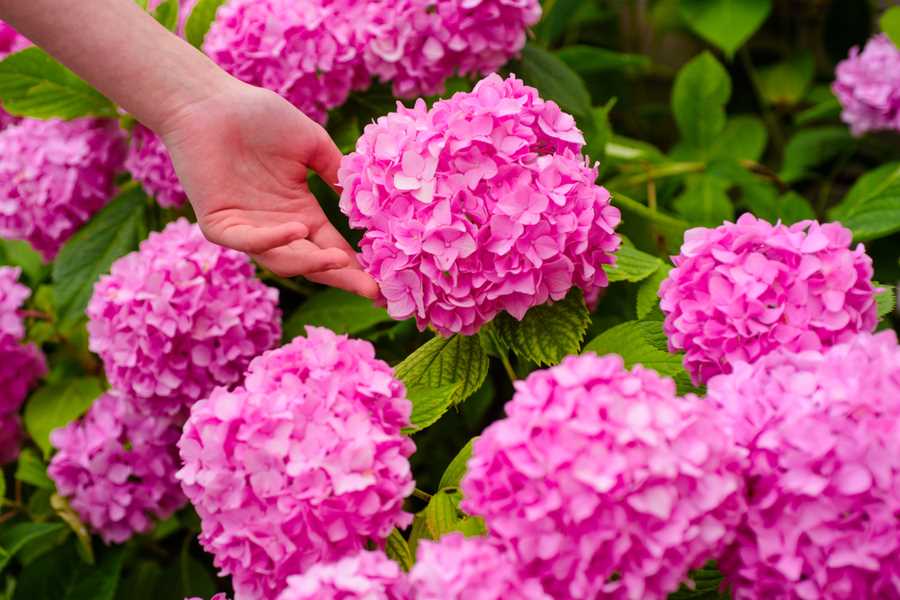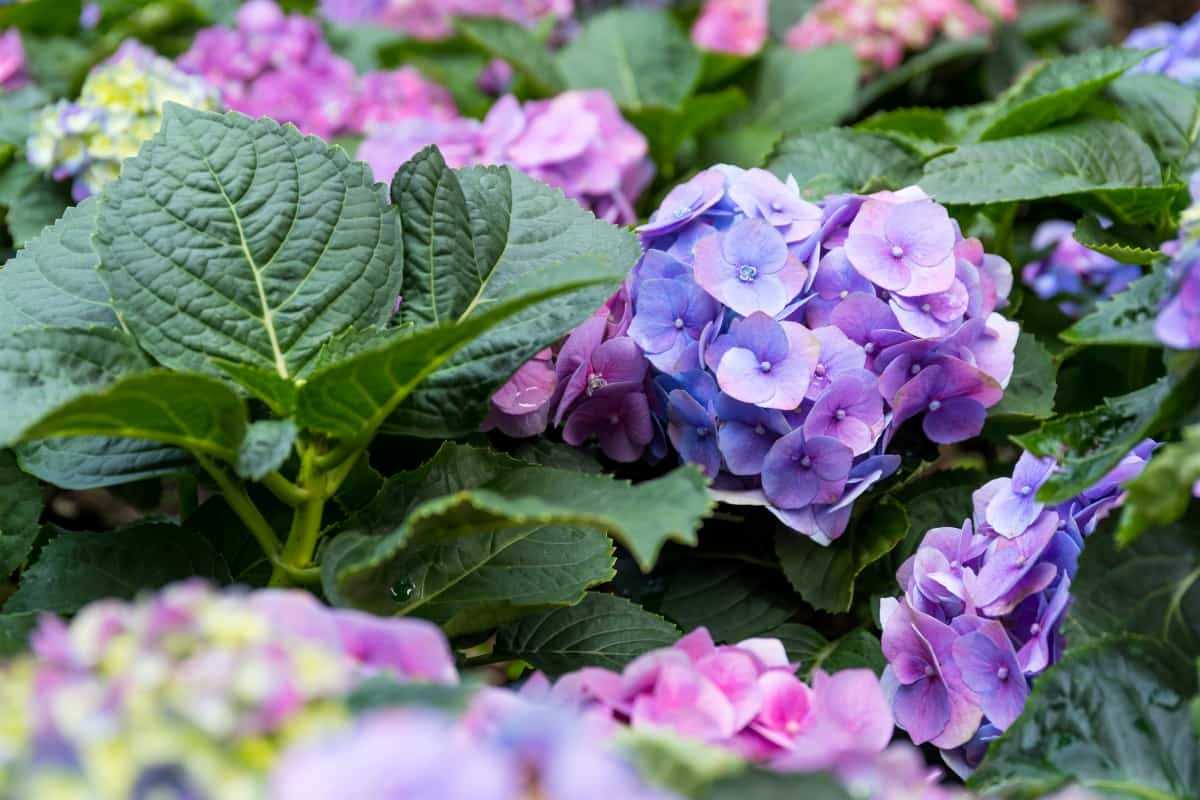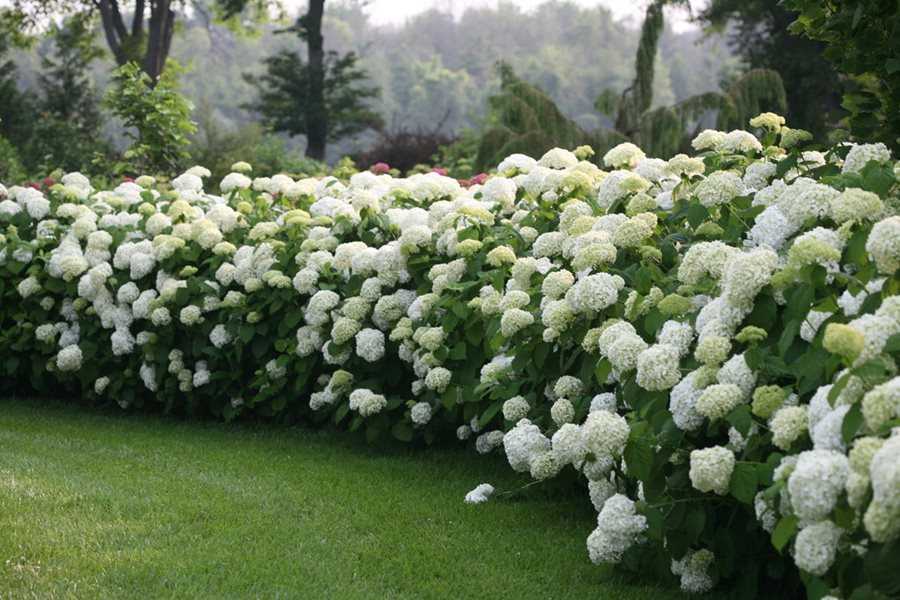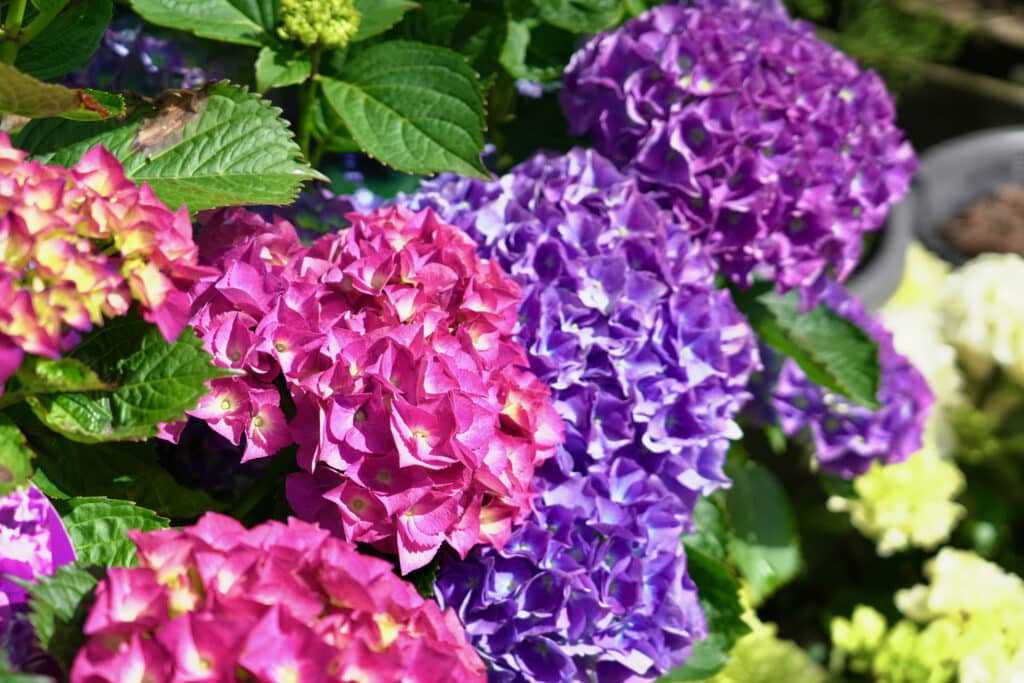- The Essential Steps for Preparing the Soil
- Understanding Hydrangeas and Their Nutritional Needs
- Importance of Soil Preparation
- 1. Nutrient Availability
- 2. pH Balance
- 3. Moisture Retention
- 4. Weed Control
- 5. Soil Structure
- Clearing the Area and Removing Weeds
- Testing the Soil’s pH Levels
- Interpretation of pH Results
- Adding Organic Matter to Improve Soil Structure
- Compost
- Manure
- Leaves
- Green Manure
- Incorporating Fertiliser into the Soil
- Tools and Materials
- Steps to Incorporate Fertiliser
- Additional Tips
- Watering and Mulching for Moisture Retention
- 1. Watering techniques
- 2. Mulching for moisture retention
- Maintaining Proper Care after Fertilisation
- Watering
- Weeding
- Pruning
- Pest and Disease Control
- Mulching
- Monitoring
- Questions and Answers:
- Why is it important to prepare the soil before fertilizing hydrangeas?
- What are some ways to prepare the soil for spring fertilization of hydrangeas?
- Can I fertilize hydrangeas without preparing the soil?
- When is the best time to prepare the soil for spring fertilization of hydrangeas?
- What happens if I don’t prepare the soil before fertilizing hydrangeas?
- Are there any specific fertilizers that are recommended for hydrangeas?
- Videos: Best Fertilizer For Hydrangeas – Blooming Bright
Hydrangeas are beautiful flowering plants that can add color and texture to any garden. They are known for their large and vibrant blooms, but in order to achieve healthy and abundant flowers, it is important to prepare the soil properly before applying fertilizer in the spring.
One of the most important steps in preparing the soil for fertilization is testing the pH level. Hydrangeas prefer slightly acidic soil, ideally with a pH level of 5.5 to 6.5. If the soil is too alkaline, the hydrangea may not be able to absorb the necessary nutrients from the fertilizer. It is recommended to use a soil testing kit or to send a soil sample to a local agricultural extension office for analysis.
Once the pH level has been determined, it is time to amend the soil. Adding organic matter such as compost or peat moss can help improve soil structure and drainage, as well as provide essential nutrients for plant growth. It is important to thoroughly mix the organic matter into the existing soil to ensure even distribution.
After the soil has been amended, it is time to apply fertilizer. Slow-release fertilizers are often recommended for hydrangeas as they provide a steady supply of nutrients over time. It is important to follow the manufacturer’s instructions for proper application rates and methods. Fertilizer should be evenly distributed around the base of the plant, taking care not to let it come into direct contact with the stems or leaves.
The Essential Steps for Preparing the Soil

Preparing the soil before fertilizing your hydrangeas in spring is crucial for ensuring healthy growth and abundant blooms. Follow these essential steps to properly prepare the soil:
- Clear the area: Start by clearing the area around your hydrangeas. Remove any weeds, rocks, or debris that may hinder proper soil preparation.
- Loosen the soil: Use a garden fork or a tiller to loosen the soil. This will improve drainage and allow the roots of your hydrangeas to penetrate the soil easily.
- Test the pH: Test the pH level of the soil using a soil testing kit. Hydrangeas prefer slightly acidic soil with a pH between 5.5 and 6.5. Adjust the pH if necessary by adding amendments like lime to raise the pH or sulfur to lower it.
- Add organic matter: Incorporate organic matter into the soil to improve its fertility and structure. This can be done by adding compost, well-rotted manure, or leaf mold. Organic matter increases the soil’s ability to retain moisture and nutrients, promoting healthy root development.
- Apply fertilizer: Before applying fertilizer, determine the specific nutrient needs of your hydrangeas. Choose a fertilizer that is formulated for hydrangeas or has a balanced NPK ratio. Follow the recommended dosage and apply the fertilizer evenly around the base of the plants, avoiding direct contact with the stems and foliage.
- Mulch the soil: After applying fertilizer, mulch the soil around your hydrangeas. A layer of mulch helps conserve moisture, suppresses weeds, and moderates soil temperature. Use organic mulch like wood chips or bark, and apply it to a depth of 2-3 inches.
- Water thoroughly: Finally, water the soil thoroughly after preparing it and applying fertilizer. Hydrangeas require consistent moisture, especially during the growing season. Water deeply to soak the soil and ensure the nutrients from the fertilizer reach the roots of the plants.
By following these essential steps, you can create a favorable environment for your hydrangeas to thrive and produce beautiful blooms. Properly prepared soil provides the necessary nutrients and moisture for healthy growth, resulting in vibrant and healthy plants.
Understanding Hydrangeas and Their Nutritional Needs
Hydrangeas are beautiful and popular flowering plants that come in a variety of colors and sizes. They are known for their large, showy blooms, making them a favorite choice for gardens and landscapes. Like all plants, hydrangeas have specific nutritional needs that must be met for them to thrive and produce vibrant, healthy flowers.
The Role of Nutrients
Hydrangeas require a range of essential nutrients to grow and develop properly. These nutrients play different roles in the plant’s overall health and flower production:
- Nitrogen (N) – Nitrogen is responsible for promoting healthy foliage growth. It helps hydrangeas produce lush green leaves and stems.
- Phosphorus (P) – Phosphorus is essential for root development and overall plant growth. It aids in flower production and enhances the plant’s ability to cope with stress.
- Potassium (K) – Potassium is vital for the overall health of hydrangeas. It strengthens the plant’s immune system, helps regulate water uptake, and improves flower color and quality.
- Calcium (Ca) – Calcium is essential for cell wall development and strength. It helps prevent diseases and promotes strong, healthy plants.
- Magnesium (Mg) – Magnesium is involved in photosynthesis and chlorophyll production. It helps hydrangeas maintain their vibrant green color and overall plant health.
Symptoms of Nutritional Deficiencies
When hydrangeas lack the necessary nutrients, they can exhibit various symptoms of deficiency. Some common signs to look out for include:
- Pale or yellowing leaves
- Stunted growth
- Poor flower production
- Leaf drop
- Weak or spindly stems
- Susceptibility to diseases and pests
Providing Proper Nutrition
In order to ensure that hydrangeas receive the necessary nutrients, it is important to prepare the soil properly and apply appropriate fertilizers. Conducting a soil test can help determine which nutrients may be lacking and guide the selection of the correct fertilizers.
When fertilizing hydrangeas, it is generally recommended to use a balanced fertilizer with equal amounts of nitrogen, phosphorus, and potassium (e.g., 10-10-10). Applying the fertilizer in early spring and again in early summer can provide adequate nutrition for healthy growth and abundant flowering. Additionally, incorporating organic matter, such as compost or well-rotted manure, into the soil can help improve nutrient availability and soil structure.
| Fertilizer | Nitrogen (N) | Phosphorus (P) | Potassium (K) |
|---|---|---|---|
| 10-10-10 | 10% | 10% | 10% |
| 14-14-14 | 14% | 14% | 14% |
| 20-20-20 | 20% | 20% | 20% |
It is important to follow the manufacturer’s instructions when applying fertilizers and avoid over-fertilization, as this can lead to nutrient imbalances and potential damage to the plants.
Conclusion
Understanding the nutritional needs of hydrangeas is crucial for their proper care and maintenance. By providing the necessary nutrients, hydrangeas can thrive, producing beautiful, vibrant blooms that enhance any garden or landscape.
Importance of Soil Preparation
The soil preparation is a crucial step in the successful fertilization of hydrangeas in the spring. Adequate soil preparation ensures that the plants receive the necessary nutrients and maintain good health throughout the growing season. Here are some reasons why soil preparation is important:
1. Nutrient Availability
Proper soil preparation helps to optimize nutrient availability for hydrangeas. The soil needs to be rich in organic matter and well-drained to promote the release of essential nutrients. This ensures that the plants can access the nutrients they need for healthy growth and vibrant blooms.
2. pH Balance
The pH level of the soil plays a crucial role in the growth and color of hydrangeas. Soil that is too acidic or alkaline can impact the plant’s ability to absorb nutrients. By testing and adjusting the pH level during soil preparation, you can create an ideal environment for hydrangeas to thrive.
3. Moisture Retention

Proper soil preparation helps to improve moisture retention, which is essential for hydrangeas, especially during dry spells. The soil should have good water-holding capacity to prevent water from draining too quickly and to provide a reservoir of moisture for the plants.
4. Weed Control
Preparing the soil before spring fertilization also helps to suppress weed growth. Removing weeds and their roots during soil preparation reduces competition for nutrients and water, providing hydrangeas with a better chance of reaching their full potential.
5. Soil Structure
The structure of the soil affects root development and overall plant health. Proper soil preparation loosens compacted soil and improves drainage, allowing the roots to penetrate easily and access essential nutrients. This promotes healthy root growth and helps the hydrangeas establish a strong foundation.
By giving attention to soil preparation before spring fertilization, you can provide hydrangeas with the ideal growing conditions for robust growth, abundant blooms, and overall plant success.
Clearing the Area and Removing Weeds

Before preparing the soil for spring fertilisation of hydrangeas, it is important to start by clearing the area and removing any weeds. Weeds can compete with hydrangeas for nutrients and water, making it crucial to get rid of them before planting or fertilising.
Here are some steps to clear the area and remove weeds:
- Start by physically removing any large weeds by hand. Pull them out from the root to prevent regrowth.
- Use a garden hoe or a hand trowel to remove smaller weeds and their roots. Be sure to get as much of the root system as possible to prevent regrowth.
- If the area is heavily infested with weeds, consider using a weed killer, such as a herbicide. Follow the instructions provided by the manufacturer to ensure safe and effective use.
- After applying any herbicide, wait for the recommended period of time for the weeds to die off before proceeding with soil preparation.
It is important to note that if you choose to use a chemical weed killer, be cautious of nearby plants and take necessary precautions to avoid damage to the hydrangeas or any other desirable vegetation in the area.
Once the area is free from weeds, you can proceed with the next steps of preparing the soil for spring fertilisation of hydrangeas. Clearing the area and removing weeds sets a good foundation for successful growth and health of your hydrangea plants.
Testing the Soil’s pH Levels
One of the crucial steps in preparing the soil for spring fertilisation of hydrangeas is testing the pH levels. The pH level of the soil greatly affects the availability of nutrients to the plants. Hydrangeas prefer slightly acidic soil with a pH level ranging from 5.5 to 6.5, as this allows them to absorb the necessary nutrients for healthy growth.
To test the soil’s pH levels, you can use a pH testing kit or a soil pH meter. These tools are readily available at garden centers or can be purchased online. Follow the instructions provided with the testing kit or meter to obtain accurate results.
Once you have collected a sample of soil for testing, ensure that it is representative of the area where your hydrangeas are growing. Take samples from various spots in the garden and mix them together in a clean container. Remove any stones, roots, or debris before testing.
Using the pH testing kit, add the recommended amount of soil and testing solution to the container. Shake it well to mix the solution with the soil. Wait for the designated amount of time mentioned in the instructions for the color or number to develop.
If you are using a soil pH meter, insert the probe into the soil sample and wait for the reading to stabilize. The digital meter will display the pH level instantly.
Interpretation of pH Results
Once you have obtained the pH reading, it’s important to interpret the results correctly:
- A pH level below 5.5 indicates acidic soil. Hydrangeas may struggle to absorb nutrients, and the addition of lime may be necessary to raise the pH.
- A pH level between 5.5 and 6.5 is ideal for most hydrangeas. The soil is slightly acidic, allowing the plants to access the required nutrients.
- A pH level above 6.5 indicates alkaline soil. In this case, the addition of sulfur or acidic fertilisers can help lower the pH and create a more suitable environment for hydrangeas.
Regularly testing and monitoring the pH levels of your soil is essential to ensure the optimal growing conditions for hydrangeas. Adjusting the pH as needed will help your plants thrive and produce beautiful blooms in the spring.
Remember to follow the instructions on your chosen soil testing method for accurate results and consult with garden experts if you are unsure about how to adjust the pH levels effectively.
Adding Organic Matter to Improve Soil Structure
One of the most important steps in preparing the soil for spring fertilisation of hydrangeas is adding organic matter. Organic matter not only provides essential nutrients for the plants but also improves the overall structure of the soil. Here are some ways to incorporate organic matter into your soil:
Compost
Compost is a valuable source of organic matter for the soil. It is made by decomposing organic materials such as kitchen scraps, yard waste, and leaves. Adding compost to the soil can help improve its structure, moisture retention, and nutrient content. Spread a layer of compost over the soil surface and gently mix it in to a depth of about 4-6 inches.
Manure
Another excellent source of organic matter is manure. Cow, horse, or chicken manure can be used to enrich the soil and improve its structure. However, it’s important to use well-aged or composted manure to avoid burning the plants due to the high nitrogen content. Apply a layer of manure to the soil and mix it in thoroughly.
Leaves
Leaves are readily available in most gardens during the fall season. Shredded leaves can be used as a mulch or added to the soil to improve its structure. Leaves help retain moisture, increase organic matter content, and promote beneficial microbial activity in the soil. Spread a layer of shredded leaves over the soil surface and incorporate them into the top layer of soil.
Green Manure
Green manure plants, such as clover or alfalfa, can also be grown and turned into the soil to improve its structure. These plants help fix nitrogen in the soil and add organic matter when tilled under. Plant green manure crops in the late summer or fall and allow them to grow until the spring. Then, cut them down and work them into the soil.
By incorporating organic matter into your soil, you can improve its structure and create a healthy environment for your hydrangeas to thrive. Remember to regularly test your soil and adjust the pH levels accordingly to ensure optimal nutrient availability for your plants.
Incorporating Fertiliser into the Soil
When it comes to fertilising hydrangeas in the spring, it is essential to properly incorporate the fertiliser into the soil. This ensures that the nutrients are available to the plants and can be absorbed effectively.
Tools and Materials
Before incorporating fertiliser into the soil, gather the following tools and materials:
- Gardening gloves
- Garden fork or shovel
- Bucket or wheelbarrow
- Fertiliser (specifically formulated for hydrangeas)
- Watering can or hose
Steps to Incorporate Fertiliser
- Choose a dry day to work in the garden when the soil is not too wet. Wet soil can make it challenging to mix in the fertiliser properly.
- Prior to incorporating the fertiliser, remove any weeds or debris from the planting area. This will help prevent competition for nutrients and ensure the hydrangeas receive the full benefit of the fertiliser.
- Put on gardening gloves to protect your hands while working in the garden.
- Using a garden fork or shovel, turn over the top layer of soil to loosen it. This will create a friable texture and make it easier to mix in the fertiliser.
- If using a granular fertiliser, carefully read the instructions on the package to determine the recommended amount of fertiliser per square foot or metre. Measure the appropriate amount of fertiliser and add it to a bucket or wheelbarrow.
- Spread the fertiliser evenly over the soil surface. Use a garden fork or shovel to lightly incorporate the fertiliser into the top few inches of soil. Be careful not to disturb the roots of the hydrangeas.
- After incorporating the fertiliser into the soil, water the area thoroughly. This will help activate the fertiliser and ensure it reaches the root zone of the hydrangeas.
Additional Tips
Here are some additional tips to keep in mind when incorporating fertiliser into the soil:
- Follow the recommended dosage and timing instructions provided by the fertiliser manufacturer for the best results.
- Consider performing a soil test to determine the nutrient needs of your specific hydrangea plants. This will help you choose an appropriate fertiliser and determine the correct application rate.
- If using liquid fertiliser, dilute it according to the instructions on the package and apply it evenly over the soil surface.
- Avoid applying fertiliser too close to the base of the hydrangea plant, as this can cause root burn or other issues.
- Regularly monitor the hydration and growth of your hydrangeas throughout the growing season. Adjust the fertiliser application as needed to maintain optimal plant health.
By properly incorporating the fertiliser into the soil of your hydrangeas, you can provide them with the necessary nutrients for healthy growth and vibrant blooms in the coming season.
Watering and Mulching for Moisture Retention
Watering your hydrangeas is crucial for their growth and overall health. Proper watering techniques can ensure that the plants receive enough moisture to thrive.
1. Watering techniques

When it comes to hydrangeas, it’s important to provide deep, thorough watering rather than frequent shallow watering. This helps promote root growth and encourages the plants to establish a deep root system.
Here are some watering techniques to consider:
- Water the plants early in the morning to allow ample time for the leaves to dry before evening. This helps prevent the development of fungal diseases.
- Focus the watering directly on the base of the plant to ensure that the root system receives the most moisture.
- Avoid wetting the foliage excessively, as this can lead to diseases and leaf damage.
- Monitor the soil moisture level regularly and adjust the watering frequency based on the weather conditions. Hydrangeas prefer moist soil but can tolerate some dryness between watering sessions.
2. Mulching for moisture retention
Mulching around hydrangeas can help retain moisture in the soil and reduce the need for frequent watering. It also helps control weeds and keeps the soil temperature stable.
Consider the following tips for mulching:
- Apply a layer of organic mulch, such as bark chips or compost, around the base of the plant. This should be done after the soil has warmed up in spring.
- Ensure that the mulch layer is around 2-3 inches thick. Avoid piling the mulch against the stems of the hydrangeas, as this can lead to stem rot.
- Regularly check the mulch and replenish it as needed. Over time, the mulch will break down and become incorporated into the soil.
By implementing proper watering techniques and mulching for moisture retention, you can help your hydrangeas thrive and ensure that they receive the necessary moisture for optimal growth.
Maintaining Proper Care after Fertilisation
Watering
After fertilising your hydrangeas, it is important to water them properly to ensure that the nutrients in the soil are distributed evenly and absorbed by the plants’ roots. Hydrangeas require regular watering, especially during hot and dry weather. However, it is important not to overwater the plants, as this can lead to root rot and other issues. Check the moisture level of the soil before watering and adjust accordingly.
Weeding
Regularly remove any weeds that grow around your hydrangeas. Weeds compete with the plants for nutrients and water, which can affect their growth and overall health. Keeping the area around your hydrangeas free of weeds will help them thrive and make it easier to apply fertilisers and other treatments.
Pruning

Pruning hydrangeas regularly is essential for maintaining their shape and promoting healthy growth. After fertilisation, remove any dead or damaged branches to improve air circulation and prevent the spread of diseases. Additionally, prune any overgrown branches to maintain the desired size and shape of your hydrangeas.
Pest and Disease Control
Monitor your hydrangeas for any signs of pests or diseases. Common pests that may attack hydrangeas include aphids, spider mites, and slugs. If you notice any pests, take appropriate measures to control their population, such as using insecticidal soap or introducing natural predators like ladybugs.
As for diseases, hydrangeas can be susceptible to powdery mildew, leaf spot, and root rot. If you notice any symptoms of these diseases, such as discolored or spotted leaves, take immediate action to prevent the spread. Remove affected leaves and consider using fungicides or adjusting watering practices to prevent the conditions that promote disease development.
Mulching
Mulching is an important step in maintaining proper care after fertilisation. Apply a layer of organic mulch, such as wood chips or compost, around the base of your hydrangeas. Mulch helps regulate soil temperature, retain moisture, suppress weed growth, and improve soil fertility. It also adds nutrients to the soil as it breaks down over time.
Monitoring
Regularly monitor the overall health and growth of your hydrangeas. Keep an eye out for any changes in leaf color, size, or texture, as these can indicate nutrient deficiencies or other issues. Also, observe the blooming patterns and adjust care practices accordingly. Monitoring your hydrangeas will help you identify and address any problems early on, preventing further damage to the plants.
In conclusion, proper care after fertilisation is crucial for the overall health and growth of hydrangeas. By following these maintenance practices, you can ensure that your hydrangeas continue to thrive and provide beautiful blooms year after year.
Questions and Answers:
Why is it important to prepare the soil before fertilizing hydrangeas?
Preparing the soil before fertilizing hydrangeas is important because it helps create optimal growing conditions for the plants. It enhances soil fertility, improves drainage, and allows better absorption of nutrients. This ensures that the hydrangeas receive the necessary nutrients to grow and bloom beautifully.
What are some ways to prepare the soil for spring fertilization of hydrangeas?
There are several ways to prepare the soil for spring fertilization of hydrangeas. Firstly, it is recommended to do a soil test to determine the pH level and nutrient content of the soil. Based on the test results, you can make any necessary adjustments, such as adding lime to raise pH or sulfur to lower it. Secondly, clearing away any debris or weeds from the area around the hydrangeas is important to prevent competition for nutrients. Lastly, loosening the soil with a garden fork or tiller and adding organic matter, such as compost or well-rotted manure, can help improve soil fertility and structure.
Can I fertilize hydrangeas without preparing the soil?
While it is possible to fertilize hydrangeas without preparing the soil, it is not recommended. Preparing the soil helps create optimal growing conditions and ensures that the hydrangeas receive the necessary nutrients for healthy growth and abundant blooming. Without proper soil preparation, the plants may not be able to absorb the nutrients effectively or may suffer from poor drainage and fertility, leading to stunted growth and decreased flowering.
When is the best time to prepare the soil for spring fertilization of hydrangeas?
The best time to prepare the soil for spring fertilization of hydrangeas is in the fall or early winter, before the ground freezes. This allows enough time for any necessary adjustments to the soil pH or nutrient content to take effect. However, if you missed the opportunity to prepare the soil in the fall, you can still do it in early spring before the plants start actively growing and before applying the fertilizer.
What happens if I don’t prepare the soil before fertilizing hydrangeas?
If you don’t prepare the soil before fertilizing hydrangeas, the plants may not receive the necessary nutrients for healthy growth and flowering. The soil may have poor drainage, leading to waterlogging and root rot. The pH level may be imbalanced, making it difficult for the plants to absorb nutrients. Additionally, competition from weeds and debris can deprive hydrangeas of necessary resources. Overall, neglecting soil preparation can result in stunted growth, poor flowering, and overall poor health of the hydrangeas.
Are there any specific fertilizers that are recommended for hydrangeas?
There are several fertilizers recommended for hydrangeas, depending on the specific needs of your soil and plants. Generally, a balanced slow-release fertilizer with a NPK ratio of around 10-10-10 is a good choice. You can also use a fertilizer specifically formulated for acid-loving plants if your hydrangeas prefer acidic soil. It’s important to follow the instructions on the fertilizer packaging and refrain from over-fertilizing, as this can lead to nutrient imbalances and potential damage to the plants.







